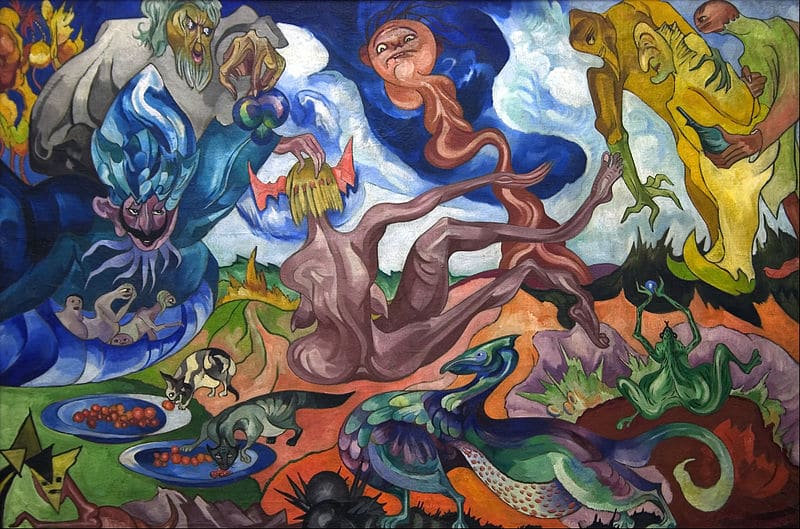
Many people experience their own birth or a re-birth while taking psychedelics. Image source: Wikimedia user DcoetzeeBot.
I felt that I was pushing against the fabric of my world. There seemed to be no way out, and there was an immense pressure as the world closed in on me. Then I felt a mounting struggle. My heart rushed as I searched for a way out. I thought I might be sick but had an extreme desire to move…to dance. When I thought I couldn’t take it anymore, at the exact moment it became too much, the pressure lifted, and I felt an intense sense of relief and stillness.
Upon reading the above paragraph, you may wonder whether someone is talking about their own birth or a recent psychedelic experience. It can be surprising how similar the two situations are. In fact, there are entire therapeutic systems based on the idea that psychedelics create a birth-like state of consciousness that can be used to open patients to new ideas and ways of thinking. Psychedelic therapists have used this sense of rebirth to help patients heal from their own traumatic birth experiences as well as treat other forms of trauma.
Grof’s Basic Perinatal Matrices
While studying LSD, pioneering psychiatrist and creator of holotropic breathwork Stanislav Grof noticed that his test subjects consistently had four distinct types of experiences they often related back to memories of their actual birth. These were:
- Feelings of suspension and oneness with the greater world.
- Being trapped and sensations of pressure or anxiety; feeling like there is no way out and no end to their torment or discomfort.
- A mix of agony and ecstasy. Extreme sexual urges mixed with sadomasochism. Fighting, conquering, and struggle.
- A period of intense tension followed by complete relaxation, often with sensations of pure white or gold light.
From this, he created the Basic Perinatal Matrices (BPM), which outlined the four phases of birth: conception to the first contraction, contractions within the uterus, entrance into the birth canal, and separation from the mother. Grof was intrigued by the way so many of his subjects seemed to relive traumatic aspects of their birth while taking LSD, especially once he confirmed through interviews with family members and hospital records that the memories his subjects were having fit the narrative of their actual birth.
He theorized that when people had a traumatic birth experience, they continued to recreate the experience in their life. For example, if you experienced a traumatic third phase of birth, you may be more drawn to thrilling, risky activities and have a high sex-drive during your life, constantly recreating your journey through the birth canal. As you repeat similar experiences over and over again, your brain condenses them into an unavoidable progression of events, making you feel helpless and impotent against them. Grof referred to these deep-held concepts as systems of condensed experience (COEX). COEXs are our subconscious way of trying to process and “fix” a traumatic aspect of the BPM, and they often lead to psychological disorders such as anxiety, depression, avoidance, or compulsive behaviors. Grof saw that LSD allowed his patients to discover the root cause of their COEX—the initial perinatal experience—and relive it in a therapeutic setting. This could eventually allow his patients to create new patterns of behavior that were not based on their previous COEXs—in essence, freeing them from their birth experience.
Nutt’s Childlike Brain
While Grof created his BPM and COEX theories in the 1970’s, there wasn’t a physiological explanation for his psychological theories for several decades. But recently, Professor David Nutt ran a brain imaging study that showed how brains function under the influence of LSD. He found that while using LSD, an individual’s brain tended to function more like an infant’s brain than a mature brain.
To understand what this means, know that infant’s brains function based on proximity. Sections of the brain that are close together work at the same time to process information and experiences, even if those areas are not functionally related. This makes infants hyper-emotional and more imaginative than adults. As a person ages, their brain becomes more specialized, with functionally similar areas working at the same time despite their distance from each other. This may offer an explanation of why people are able to remember early childhood experiences and even their birth with the assistance of psychedelics; those memories are locked in a different processing technique and “forgotten” as a person’s brain becomes more efficient. But because psychedelics stimulate the brain to function based on proximity once again, those forgotten memories can be brought to the surface and addressed.
Using the Rebirth Experience In Psychedelic Therapy
The concept of rebirth and an infant-like brain can be used in psychedelic therapy to help patients overcome psychological disorders that result from repeated negative processes throughout your life—whether they stem from a traumatic birth experience or not.
For Grof, psychedelic therapy consisted of allowing a person to rediscover their early trauma. He found that after the simple act of reliving their traumatic birth experience, it was no longer a powerful, driving force in their life. Other therapists may encourage you to take a more active role in your therapy, though. Instead of reliving a traumatic sensation, they may suggest you restructure the experience in a less traumatic way. If you experience claustrophobia and anxiety related to a traumatic second phase of birth, for instance, your therapist may have you create a way out of the womb while you are under the influence of psychedelics.
If your trauma occurred after birth—such as experiencing abuse or a traumatic life event—your therapist may have you focus on your trauma during your therapy and use the concept of the infant-mind to reform the way you think about or remember the event in order to decrease your emotional and physical reaction to the memory. This can help treat PTSD, anxiety, eating disorders, and some forms of depression.
The rebirth of the human spirit is just one theory that explains the effectiveness of psychedelic therapy. It is a useful tool for structuring therapy sessions and exploring your psychological disorder, but it is not the only effective strategy used by psychedelic therapists. Anaclitic psychedelic therapy involves forming strong, healthy connections with others in order to fulfill the basic human need for affection, while hypnodelic therapy utilizes psychedelics to assist in hypnotic suggestive therapy. When you meet with a psychedelic therapist, you should discuss the various types of therapy and exploration you are comfortable with in order to create a personal treatment plan that is effective for you.









